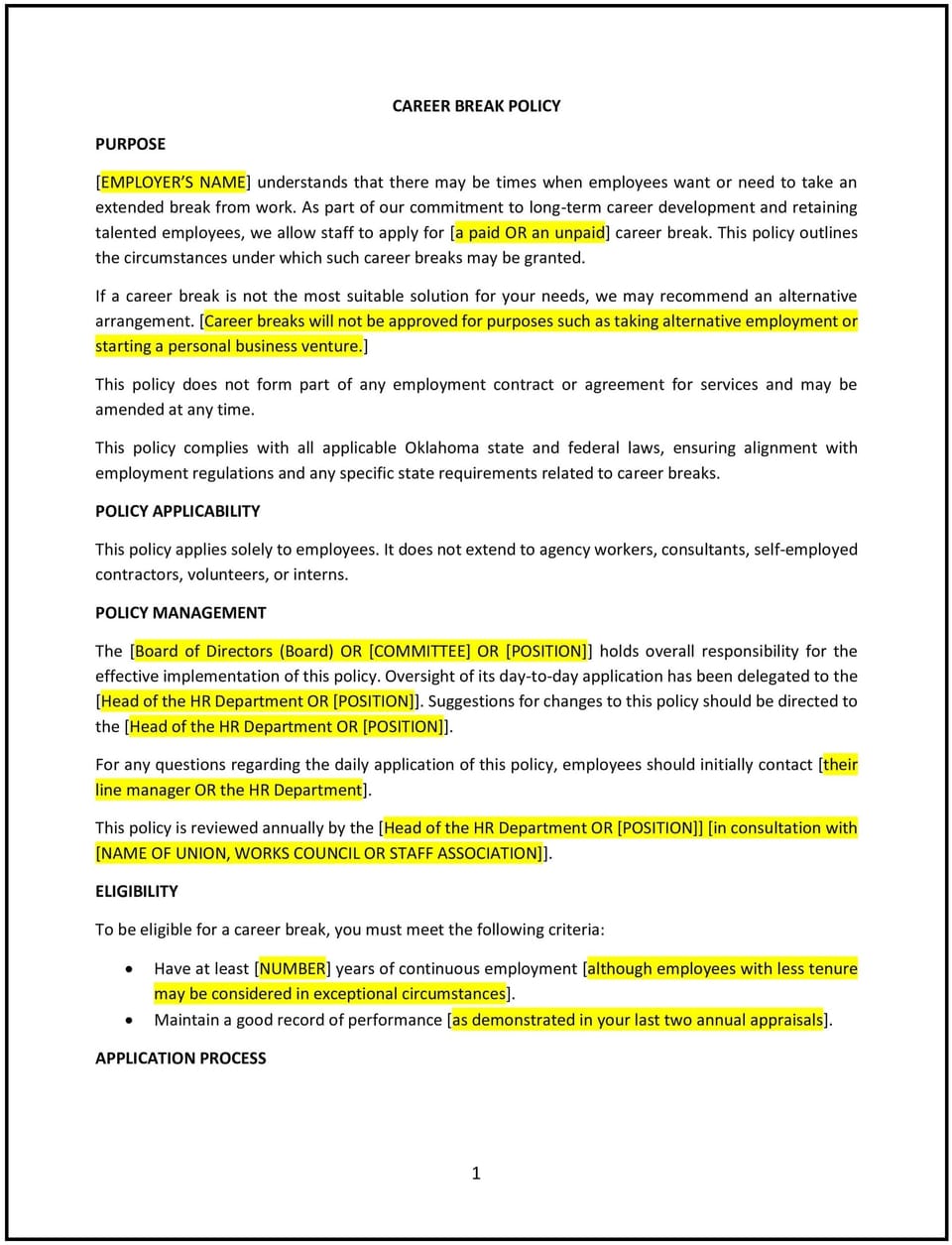Career break policy (Oklahoma): Free template

Career break policy (Oklahoma)
This career break policy is designed to help Oklahoma businesses establish clear guidelines for employees seeking an extended leave of absence for personal, educational, or professional development reasons. The policy outlines eligibility, application procedures, and return-to-work expectations to ensure consistency in managing career breaks.
By implementing this policy, businesses can support employee well-being while maintaining operational stability.
How to use this career break policy (Oklahoma)
- Define eligibility: Specify which employees qualify for a career break based on tenure, job role, or business needs.
- Establish application procedures: Require employees to submit a formal request outlining the reason for the career break and the intended duration.
- Set approval criteria: Detail how management will evaluate requests, considering business impact and workload management.
- Outline duration limits: Specify the maximum and minimum length of career breaks allowed under the policy.
- Address job security: Clarify whether employees are guaranteed a role upon returning and how re-entry into the workforce will be handled.
- Provide return-to-work guidelines: Define the steps for employees to transition back into their roles, including potential training or reintegration support.
- Review regularly: Periodically assess the policy to reflect changes in workforce planning and Oklahoma-specific business practices.
Benefits of using this career break policy (Oklahoma)
Implementing this policy provides several advantages for Oklahoma businesses:
- Supports employee retention: Encourages long-term commitment by offering structured leave options.
- Reduces turnover costs: Provides a pathway for employees to return rather than resign permanently.
- Promotes workforce flexibility: Allows businesses to manage temporary absences effectively.
- Ensures operational planning: Helps businesses anticipate and prepare for workforce gaps.
- Reflects Oklahoma-specific workforce considerations: Tailoring the policy to local business practices enhances its practicality.
Tips for using this career break policy (Oklahoma)
- Communicate options clearly: Ensure employees understand the process and conditions for taking a career break.
- Plan for coverage: Develop contingency plans for workload redistribution during an employee’s absence.
- Maintain open communication: Encourage periodic check-ins to keep employees informed about potential changes at work.
- Facilitate reintegration: Provide training or orientation sessions for returning employees.
- Monitor policy effectiveness: Gather feedback and adjust guidelines based on business and employee needs.
Q: Who is eligible for a career break under this policy?
A: Businesses should define eligibility based on factors such as length of service, performance history, and business requirements.
Q: How long can a career break last?
A: Businesses should specify a minimum and maximum duration, typically ranging from a few months to a few years, depending on company policy.
Q: Are employees guaranteed a job upon return?
A: Businesses should clarify whether employees will be reinstated to their previous role or a comparable position.
Q: What happens if an employee decides not to return after a career break?
A: Businesses should outline expectations and require employees to notify HR within a specified timeframe if they choose not to return.
Q: Can employees extend their career break?
A: Businesses should specify whether extensions are permitted and what approval process applies.
Q: Will benefits continue during a career break?
A: Businesses should detail whether employees will retain benefits such as health insurance, retirement contributions, or paid time off accruals.
Q: How often should this policy be reviewed?
A: The policy should be reviewed annually or as needed to reflect changes in workforce strategy, employee needs, or Oklahoma regulations.
This article contains general legal information and does not contain legal advice. Cobrief is not a law firm or a substitute for an attorney or law firm. The law is complex and changes often. For legal advice, please ask a lawyer.


